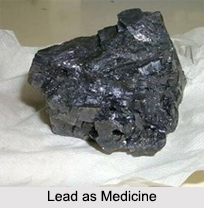 Lead is produced abundantly in India in the shape of the sulphide called galena. Galena is sold in the markets under the name of Surma, and is much used by the natives as a collyrium. The red oxide of lead, or minium, was manufactured by the ancient Hindus. It is known by the name of Sindura, and is used by all married Hindu women as a paint for the forehead.
Lead is produced abundantly in India in the shape of the sulphide called galena. Galena is sold in the markets under the name of Surma, and is much used by the natives as a collyrium. The red oxide of lead, or minium, was manufactured by the ancient Hindus. It is known by the name of Sindura, and is used by all married Hindu women as a paint for the forehead.
Processing of Lead
Lead is purified and reduced to powder in the same way as tin. Lead thus prepared is a gritty powder of a greyish red colour. Chemically it is an impure carbonate of lead. Its properties are said to be similar to those of tin.
Benefits of Lead
Lead is seldom used internally except as a component of compound medicines containing a number of other metals. A probe made of lead is preferred for applying collyria to the eyelids.
Dose of Lead in Medicine
The red oxide of lead, called Sindura is used externally in eruptive skin diseases in the form of ointment or liniment. Thus Sindura and powdered black pepper mixed with butter is recommended to be applied in chronic eczema.
An oil called Sinduradya Taila is thus prepared. Take mustard oil 1 seer, water 4 seers, minium 4 tolas and cumin seeds 8 tolas. Boil together in the usual way. This oil is used in eczema and other eruptive skin diseases.
This article is a stub. You can enrich by adding more information to it. Send your Write Up to content@indianetzone.com




















